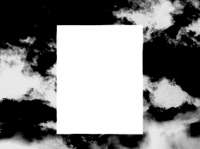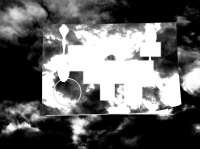Mapping Obscura - a Proposal for a Memorial to Partition
Mapping obscura is a mobile memorial, a camera obscura that travels through landscape and into communities. Visitors are invited to enter the camera to compose photograms, arranging objects of personal significance against a background provided by the camera’s shifting interior projections.
Traditionally, a camera obscura is a box or room with a lens embedded in one wall, through which an inverted image of the outside world is projected onto the camera’s interior. mapping obscura is constructed from a large wood- en shipping container with a lens installed in its ceiling. Through this lens, continuously shifting images of the sky are projected onto the interior floor. Visitors to mapping obscura are asked to bring objects of personal history— snapshots and mementos—into the space. Working under a safelight, visitors arrange these objects atop a sheet of photo paper placed on the camera’s floor.
Once the lens cap is removed, the solid and opaque objects obscure parts of the image of the sky above projected downward onto the photo paper. The exposure fixes each particular constellation of objects as an array of blank, negative spaces, a series of hard-edged, graphic elements against a background of shifting views of the sky. However, the variable layering of objects and unex- pected traces of light leaks during exposure are integral and expressive aspects of the process. Visitors may make as many photograms as desired, adapting their arrangements to the amorphous projections, to the subtle shifts in light within the room.
Objects are containers for memories. The associations for a given object are subjective, multiple and fragmented, and parallel the transience of personal memories. Yet, collectively, we recognize objects as placeholders for the past. In this way, memories take shape.
The images produced in mapping obscura attempt to cast memories, carried in objects, onto a sense of place. Details may be blurred or lost but the contours of the past etch themselves in different ways onto a shifting landscape. The memorial, and its resulting photo works, explore this tension and ambiguity, creating punctuated moments located somewhere between that which is fixed and that which is elusive.
Mapping Obscura - a Proposal for a Memorial to Partition
Mapping obscura is a mobile memorial, a camera obscura that travels through landscape and into communities. Visitors are invited to enter the camera to compose photograms, arranging objects of personal significance against a background provided by the camera’s shifting interior projections.
Traditionally, a camera obscura is a box or room with a lens embedded in one wall, through which an inverted image of the outside world is projected onto the camera’s interior. mapping obscura is constructed from a large wood- en shipping container with a lens installed in its ceiling. Through this lens, continuously shifting images of the sky are projected onto the interior floor. Visitors to mapping obscura are asked to bring objects of personal history— snapshots and mementos—into the space. Working under a safelight, visitors arrange these objects atop a sheet of photo paper placed on the camera’s floor.
Once the lens cap is removed, the solid and opaque objects obscure parts of the image of the sky above projected downward onto the photo paper. The exposure fixes each particular constellation of objects as an array of blank, negative spaces, a series of hard-edged, graphic elements against a background of shifting views of the sky. However, the variable layering of objects and unex- pected traces of light leaks during exposure are integral and expressive aspects of the process. Visitors may make as many photograms as desired, adapting their arrangements to the amorphous projections, to the subtle shifts in light within the room.
Objects are containers for memories. The associations for a given object are subjective, multiple and fragmented, and parallel the transience of personal memories. Yet, collectively, we recognize objects as placeholders for the past. In this way, memories take shape.
The images produced in mapping obscura attempt to cast memories, carried in objects, onto a sense of place. Details may be blurred or lost but the contours of the past etch themselves in different ways onto a shifting landscape. The memorial, and its resulting photo works, explore this tension and ambiguity, creating punctuated moments located somewhere between that which is fixed and that which is elusive.

